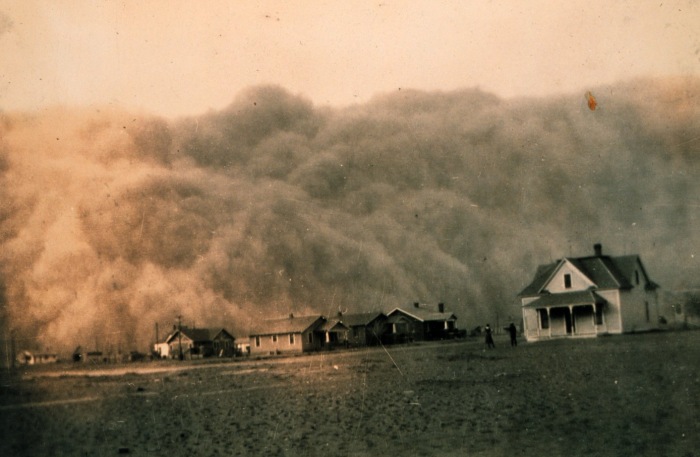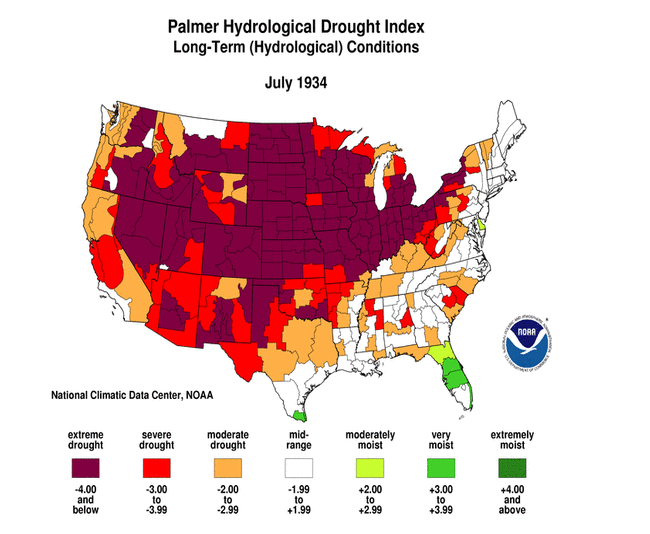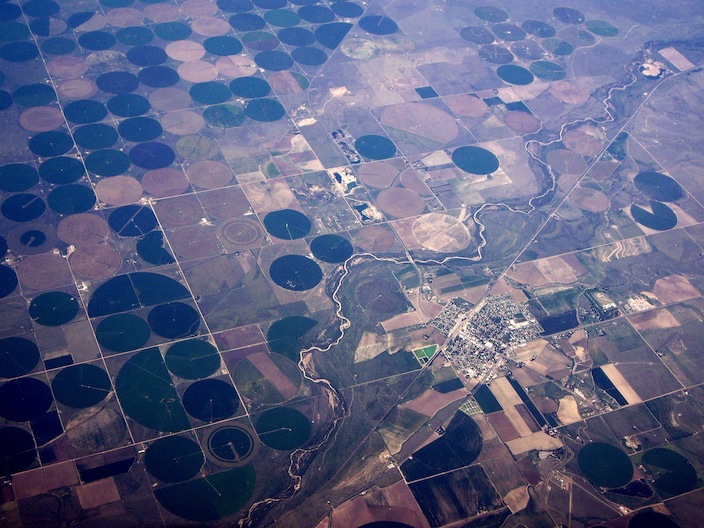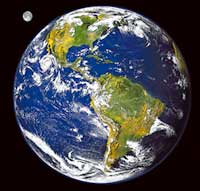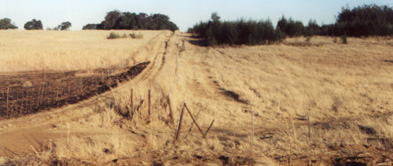 The Dust Bowl, 1930s.
The Dust Bowl, 1930s. 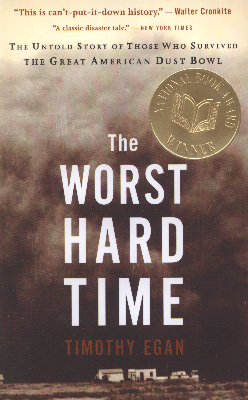
Readings
"Witnesses testified about towns with a foot in the grave, farms abandoned, land that had not produced a crop in in four years, families sick and hungry, schools closed, and the only hope a miracle . . . "
Dust Bowl, by Alexandre Hogue (1933) (oil), Kansas Geological Survey.
quote from Egan, p. 223.
"If we are bold in our thinking, courageous in accepting new ideas, and willing to work with instead of against our land, we shall find in conservation farming an avenue to the greatest food production the world has ever known - not only for the war, but for the peace that is to follow."
Hugh Hammond Bennett, USSCS,1943.
economic collapse | weather | map | photographic evidence | conservation | means | 80 million acres lost | review | contents
The paradox of agricultural economics
"The stock market's loss was up to fifty billion dollars. In three months time, two million Americans lost their jobs–a tripling of what unemployment had been at the end of summer. Charles saw something in the city he had never seen in No Man's Land: young people, dressed well, heads toward the ground, waiting on line to get something to eat. And he saw. . . people sleeping under bridges."
"No one has yet starved,' said President Herbert Hoover, trying to calm people at year's end. He spoke too soon. A few months later people rioted in Arkansas, demanding food for their children. Then it happened closer to home. A mob stormed a grocery store in Oklahoma City, after the Mayor had rejected their petition for food. Rioting over food, how could this be?"
p. 78.
"Farmer's begged the banks to give them one last chance. Foreclosure sales in Boise City. . . became a regular event."
"After a while, farmers got wise to the sales and devised a scheme. Before each foreclosure event, they agreed to bid a dime for a horse or combine and no more. . . .For a time, these ten-cent sales kept a few bankrupt nesters in the game."
This time. . . .
"They plowed up more land than had ever been plowed before for wheat. But as the Lucas family and the Folkers and the other's put in next year's crop in the fall of 1930, they noticed some fields that had been cut and opened just twelve months earlier were bare now."
The "suitcase farmers."
"They had no sooner plowed up several million acres than they walked away, leaving the land stripped, not even planted in wheat. Just naked, exposed to the wind."
p. 80.
economic collapse | weather | map | photographic evidence | conservation | means | 80 million acres lost | review | contents
Comparative Table
Technology that transformed the Great Plains Soil Conservation Hugh Hammond Bennett Railroads & Telegraph (April 15, 1881–July 7, 1960)
barbed wire fencing wind mills
"Every year the Mississippi alone pours into the Gulf of Mexico more than 400 million tons of mud, most of which comes from cultivated land within the Mississippi Valley. This is but a small part of the loss." McCormick reaper (1831-1847) The plow that broke the plains Rural Electrification Mechanization of farming saved labor and boosted the yield of crops per acre. Eighty million acres were directly and adversely affected by the Dust Bowl.
Egan, p. 135."And it hurt, like a swipe of coarse sandpaper on the face."
"On September 14, 1930, a windstorm kicked up dust out of southern Kansas and tumbled toward Oklahoma. By the time the storm cut a swath through the Texas Panhandle, it looked unlike anyone had ever seen before on the high plains."
"...it rolled, like a mobile hill of crud, and it was black."
Egan, p. 88. On April 14, 1935, a freakish storm barreled through the Texas Panhandle, sweeping up 300,000 tons of topsoil. The dirt sailed through the air, choking people and animals, blanketing houses and cars. All told, the duster ripped up twice as much dirt as was dug out of the Panama Canal during seven years of construction. The storm, however, needed only a Sunday afternoon to do so. That was Palm Sunday. "People tried to explain it."
"The drought was in its fourth year, and it was the worst in at least a generation's time. But long dry periods were as much a part of the Great Plains as the grass itself. What was different in 1935 was that the land was naked."
Egan, pp. 222 - 223.
Palmer Hydrologic Drought Index, compare to current year.
economic collapse | weather | map | photographic evidence | conservation | means | 80 million acres lost | review | contents
"He turned to the north and saw what looked like the leading edge of a fast moving cloud. ...–a tidal wave of roiling black–just a quarter mile away.
"In an instant the duster showered down on them, dirt streaming through the fine openings of the little cabin. . . . They lit the flame [of a kerosene lantern], but it went out; there was not enough oxygen in the space to keep it alive. Joe lay on his stomach, a shirt over his head, the air snapping like gunfire, coarse sand swirling. . . . What scared him now was the blackness, as if the sun had been shot out of the sky. And it was cold."
Even worse: "Black Sunday" was simply the worst day of the protracted Dust Bowl that struck in the Great Depression era, an almost decade long period of economic contraction coupled to enduring drought and killer dirt storms that beat down the settlers of the western Texas and Oklahoma Panhandles.
The reward for those who stuck it out?
"Life in the galloping flatlands was a pact with nature. It gave as much as it took, and in 1935 it was all take."
A chance to keep scratching a meager living out of the ground.
For many the unrelieved storms of dirt or finer dust meant death (pp. 170, 197.) from "dust pneumonia," for others bankruptcy (pp. 97, 178) and still others left the high plains (p. 310).
How did it happen? | What was Done? | Showdown | High Plains
economic collapse | weather | map | photographic evidence | conservation | means | 80 million acres lost | review | contents
Chapter 14. Showdown in Dalhart, Texas.
“Conservation,–that was the new word coming from Big Hugh Bennett.
"This tomorrow land was running out of tomorrow people."
"He had sent one of his scientists to Dallam County, and the man told farmers they had been 'practicing suicidal production' on the land. If the government was going to help, people would have to promise , in writing, to change their ways, would have to act as one. But getting a community consensus looked like a hard thing to do at a time when most people were still in shock....”
p. 178.
"But this was their only hope, this soil conservation idea that Big Hugh Bennett was trying to get people to agree on. Bennett's men had proposed turning a big stretch of swirling prairies in Texas into a demonstration projects of how to hold down the earth, the largest such project in the country. But it would require a majority of people in the county to approve the plan....The country might spring back to life."
p. 182.
"Bennett had told Congress that fifty-one million acres were so eroded that could no longer be cultivated. It would take a thousand years to rebuild an inch of topsoil."
"Texas was a unique disaster, for the programs 'Big Hugh (Bennett) had up and running elsewhere were all designed to stem water erosion. Wind was the problem of the High Plains."
p. 183.
economic collapse | weather | map | photographic evidence | conservation | means | 80 million acres lost | review | contents
Books
Timothy Egan, The Worst Hard Times
The High Plains:
"Now they were stuck in No Man's Land, a long strip of geographic afterthought in the far western end of the Oklahoma Panhandle, just a sneeze from Texas.
"The chill, hurried along by the wind, made it impossible to stay warm. The land was so threadbare. It was here that the Great Plains tilted, barely susceptible to most eyes, rising to nearly a mile above sea level at the western (Rocky Mountains) edge.
"They seldom saw a tree. . . ."
pp. 13-14.
economic collapse | weather | conservation | means | Eighty million acres lost | reviews | contents
Irrigated fields in western Kansas in the 21st century.
economic collapse | weather | map | photographic evidence | conservation | means | 80 million acres lost | review | contents
THE PROMISE: The Great Plow-up, 1901-1930.
Chapter 1: "The Wanderer"
In chapter 1: we meet the Whites 1926, & Dawsons, with mention of the Osteens (1909) all in Dalhart, Texas.
The southern plains in the winter 1926:
"There wasn't even grass for the horse team; the sod that hadn't been turned was frozen and brown. Windmills broke the plain, next to dugouts and sod houses and still-forming villages."
p. 14.
Cimarron -- {Mexican Spanish & Apache derived word] means wanderer
pp. 14-15.
". . . the Canadian River, the only reliable running water in the region."
Coronado, 1541
"Indians on foot passed through following bison."
the Querechos (early Apache people were here before the horses came 1670s)
Comanche, "At their peak in the mid 1700s, they numbered about 20,000." Horse riders who were Shoshones from an area of Wyoming, had migrated south to hunt bison, antelope and deer.
p. 15.
"Bison gave them just about everything they needed: clothes, shelter, tools, and of course, a protein source that could be dried, smoked, and stewed. Some tepees required twenty bison skins, . . . ."
p. 16.
Medicine Lodge Treaty of 1867
"the Great American Desert, the area south of the Arkansas River. At the time, there was no more disparaged piece of ground in the coast-to-coast vision of manifest destiny.
"To the Indians would go the land that nobody wanted.”
p. 17."the prairie where the wind blew free. . . . where there were no enclosures, and where everything drew free breath." Ten Bears, Comanche
1870-72 "Anglo hunters invaded the treaty land"
"They killed the bison by the millions stockpiling hides and horns for a lucrative trade back east."
p. 17.
""Empty of bison and Indians, the prairie was a lonely place; it had taken barely ten years to eliminate them. In victory, the American government was not sure what to do with the land.""The High Plains continues to be the most alluring body of unoccupied land ". . . USGS survey reported in the 1900s
A land of "resilient buffalo turf, and nutrient rich grama [grass], part of what Coronado called 'an immensity of grass.' Horizon to horizon, buffalo heaven and a cattleman's dream. . . . "
"The New World's magical endowment – grasslands covering 21 percent of the United States and Canada, the largest single ecosystem on the continent outside of the boreal (northern) forest."
470 native species of grasses ". . . nearly twenty million acres, was grass. In the Spring, the carpet flowered amid the green, and as wind blew, it looked like music on the ground."
p. 19.
" Great American Desert. It was Stephen Long, trying to find something of value in the treeless wilderness who first used those words in 1820, later printed on maps that guided schooners west. It would stay as cartographic fact [map maker's markings] until after the Civil War, when the Great American Desert became the Great Plains."
p. 22.
"Zebulon Pike . . .had compared it to the African Sahara in his [1806] report to the President. " [Jefferson]
"It was a vast empty sea, invariably described as featureless and frightening by the Americans who traveled through it."
Long "that it is most wholly uninhabitable by a people depending on agriculture for their subsistence."
p. 23.
"The train ride was free."
"sure it rained less than 20 inches per year, . . . the accepted threshold for growing a crop."
dry farming, irrigation, & dryland wheat were promoted by the land syndicate & the USDA
"Rain follows the plow? Damn right!"
"The Santa Fe Railroad printed an official looking progress map, showing the rain line –twenty inches or more, annually – moving west about eighteen miles a year with new towns tied to the railroad.
p. 24
XIT Ranch hands - cowboys knew that "the Panhandle was no place to break sod."
"the land was high and cold, with little drainage and nearly treeless in its entirety."
p. 25.
"As for rainfall the average was sixteen inches a year, not enough, . . . to sustain a crop."
"the elevation was 4,600 feet."
"The Panhandle was good for one thing only: growing grass."
"Most of the land was short buffalo grass, which, even in the driest, wind-lacerated years, held the ground in place."
"This turf had supported the southern half of the great American bison herd, up to thirty million animals at one point."
"The best side is up , . . don't plow it under."
But "Nesters and cowboys hated each other; each side thought the other was trying to run the other off the land."
p. 25.
"Miles to water, miles to wood, only six inches to hell."
p. 26.
"Prohibition saved the broomcorn farmers, making grain more valuable as alcohol. . . ."
p. 27.
Osteen family - a barrel of corn whiskey every day "every day, nearly every year of Prohibition."
p. 28.
Dr. George Waller Dawson and his wife, Willie-Catherine ran the sanitarium:
"The nest egg would be in the land." "It was their last best chance, he told his family."
p. 29.
Three months of cowboy's wages were equal to $100
6,000 people lost their lives in the Galveston hurricane of 1900"The ranching went well, but the real money was in town building."
p. 30.
Bam White's motivation after being stranded in Dalhart was to"get a small piece of the world and make it work."
p. 31.
economic collapse | weather | map | photographic evidence | conservation | means | 80 million acres lost | review | contents
Christian Science Monitor, from the January 10, 2006 edition
The black storms that swept America's plains Before Katrina: The tale of the Depression-era Dust Bowl.
By Stacy A. Teicher
As he reached back more than 70 years to chronicle America's epic dust storms, Timothy Egan couldn't have known his book would be released on the heels of hurricane Katrina. The weather patterns of today's Gulf Coast are completely different from those of the Depression-era Dust Bowl of the Great Plains. But the human stories are kin.
The Worst Hard Time depicts physical hardship on a larger scale than anything in recent American memory. In a literal No Man's Land - the chunk of Oklahoma tucked between Kansas, Texas, Colorado, and New Mexico - some of Egan's real-life characters struggle for years not only to survive, but simply to breathe. In frequent storms, millions of tons of dirt rain down from wind-whipped clouds, half burying homes and seeping in even through cracks covered with wet sheets.
Yet there's a strange promise inherent in this story. Readers willing to cross paths with the depths of human misery will also be rewarded with a deeper understanding of the capacity to survive - the ability to muster up courage, strength, and even optimism with which to bring new life into a world which seems unrelentingly dark.As well as unearthing memories from diaries and elderly survivors, Egan fits together a compelling context - the interplay of politics, money, environmental forces, and the gamut of human motivations.
The setting is a swath of land once inhabited by native peoples, native grasses, and bison - land that existed in a sustainable cycle for hundreds of years.
But late in the 1800s, a homesteading law and tales of quick money began luring white farming families to settle in the region. And as these settlers arrived, they immediately began to plow up the grass - with disastrous results for the land.
"The tractors had done what no hailstorm, no blizzard, no tornado, no drought . . ., nothing in the natural history of the southern plains had ever done," writes Egan. "They had removed the native prairie grass ... so completely that by the end of 1931 it was a different land - thirty-three million acres stripped bare in the southern plains."
Just as the wheat crops abounded, prices plummeted during the Depression, and thousands of families started down the path to dire poverty. With nothing to hold down the dry earth during drought, dust storms were a way of life by 1933.
In Boise City, Oklahoma,, Hazel Lucas Shaw "watched the dust ... spread over the china, into the bedroom, onto the sheets. ... Some days Hazel put on her white gloves and sat at the table - a small act of defiance ... both silly and brave."
Even more bravely, she decided to have a child, and despite the air that doctors warned was unhealthy, she and her husband refused to leave their land.
They would change their minds a year later, but the rest of their story is best left to be discovered as Egan paces it out. He weaves together the tales of several families with stunning detail, displaying skills crafted as an author and a Pulitzer Prize-winning reporter for The New York Times.
The wider world of local and national politics comes to life on a human scale as well. President Franklin Roosevelt manipulated banking and agricultural policies in an attempt to rescue Plains farmers, and he appointed scientist Hugh Bennett to head up a new agency to stabilize the soil. To get funding for a project, Bennett timed a presentation to congressmen to coincide with a dust storm; its clouds reached all the way to Washington and dropped the dirt of Oklahoma outside their window.
Just a few days before, residents of the Dust Bowl had endured Black Sunday - April 14, 1935 - when "the mother of all dusters" rendered people unable to see their hands in front of their faces.
Descriptions of illness in this book - affecting both people and animals - may seem unrelenting. But there are also victories and moments of light for those who prefer to focus on the spirit of survival.
For Ike Osteen, graduation day in 1935 was one such moment. His high school in Baca County, Colorado, reclaimed the gym from the Red Cross emergency center in time for him to get his diploma - one of only nine children in his family to do so.
Osteen maintained his love for the land. After World War II, he returned to Baca County, where - as he approached his 90th birthday - he told Egan his story.
• Stacy Teicher is on the Christian Science Monitor staff.
economic collapse | weather | map | photographic evidence | conservation | means | 80 million acres lost | review | contents
'The Worst Hard Time,' by Timothy Egan
The Anti-JoadsReview by ELIZABETH ROYTE
TIMOTHY EGAN'S new book, "The Worst Hard Time," takes the shape of a classic disaster tale. We meet the central characters (the "nesters" who farmed around the Oklahoma and Texas panhandles); dire warnings (against plowing) are voiced but ignored; and then all hell breaks loose. Ten-thousand-foot-high dust storms whip across the landscape, choking people and animals, and eventually laying waste to one of the richest ecosystems on earth.
Racing at 50 miles an hour, the Dust Bowl storms of the 1930's blasted paint off buildings; soil crushed trees, dented cars and drifted into 50-foot dunes. Tsunamis of grasshoppers devoured anything that drought, hail and tornadoes had spared. To the settlers, "it seemed on many days as if a curtain were being drawn across a vast stage at world's end." Families couldn't huddle together for warmth or love: the static electricity would knock them down. Children died of dust pneumonia, and livestock suffocated on dirt, their insides packed with soil. Women hung wet sheets in windows, taped doors and stuffed cracks with rags. None of this really worked. Housecleaning, in this era, was performed with a shovel.
As banks, churches and businesses closed, food became scarce and the nesters fought back. They paid rain merchants to shoot explosives into the sky. They clubbed to death tens of thousands of wheat-fattened rabbits and poured boiling water on the tarantulas and centipedes that covered their plank walls. Starving, they pickled tumbleweed, and ate yucca roots and roadkill.
The book's High Noon, written in cinematic stop-time, is April 14, 1935, which dawned with unusual promise: the sky blue and the sun warm. Grateful for the respite from dust, families shoveled out their houses and filled washtubs for their sheets and clothes. Then, with only a few minutes' warning, "the mother of all dusters" swooped out of the north, "the air snapping like gunfire." The dirt was so thick that a man could get lost half a block from his own home. There wasn't enough oxygen in a shelter to keep a lantern lighted. Anyone caught outside dropped to the ground and faced the prospect of being buried alive.
Black Sunday's dust - double the amount of dirt excavated to create the Panama Canal - reached the halls, and consciousness, of Washington. At first, Egan says, Franklin Roosevelt had viewed the wreckage of the plains as "a natural disaster requiring relief." He created jobs, sent food and paid farmers to reduce supply. But as the dusters continued, debate swirled: did the storms signal an irrevocable shift in nature or a shorter cycle of drought? And then, the $10 million question: did human behavior have something to do with it?
Roosevelt was lucky to be advised by Hugh Bennett, a soil scientist who talked about conservation at a time when this value was linked exclusively to the big and the scenic: snowcapped mountains, rushing rivers, trophy elk. Through Bennett, the president came to understand that it wasn't weather or bad luck that created the Dust Bowl: it was man's hubris and ignorance. Rain was historically scarce in the High Plains; when it quit altogether in 1931, wheat farmers, who'd overturned the land in a speculative frenzy, tried to cover their losses by plowing and planting more. When prices crashed, farmers abandoned their fields. Soil calcified, then went airborne.
Perhaps stung by critiques of ecocentrism in "Lasso the Wind," his 1998 book about the New West, Egan here refrains from making overt parallels between the false environmental steps of the 30's and the false steps of today. But he does blame the government outright for setting the Dust Bowl's stage: clearing the land of bison to make way for cattle, offering incentives that lured settlers to plow, stimulating wartime demands and encouraging unsustainable practices.
The story of the Dust Bowl is inherently dramatic, and Egan, a national correspondent for The New York Times, vividly brings both his witnesses and the weather to life. The book is, for the most part, thrilling. But Egan trips himself up with redundant outrage and with iterations of superlatives: the High Plains are "the best grassland in the world" and also "the greatest grassland under the heavens." The bison is "the finest grass-eating creature on four legs," and it ate "the richest sod on earth." The author takes far too many stabs at explaining why anyone opted to stay in the Dust Bowl, instead of following the Joads, and he slips from inventive, wonder-filled descriptions of the landscape to pure bluster (the native grassland species were "a perfect fit for a big neighborhood of tough winds and unforgiving sun") and cowboy talk (a town "where dreams took flight on the last snort of a dying horse," people "who believed in tomorrow because it was all they had in the bank").
In 1935, Roosevelt established the Soil Conservation Service: nesters rotated crops, fallowed land and built natural barriers, irrigation ponds and holding tanks. Grass was restored in some areas, but after the rains returned and wheat prices rose in the 40's, farmers ripped up millions of newly planted trees and started busting up sod once again. "The Worst Hard Time" ends before this failure, but not before Egan, in an epilogue, gets in a quick dig against destructive federal subsidies and Texans' depleting the Ogallala aquifer. You can't blame him for feeling angry. The High Plains have never fully recovered.
Elizabeth Royte, whose most recent book is "Garbage Land: On the Secret Trail of Trash," is a frequent contributor to the Book Review.
economic collapse | weather | map | photographic evidence | conservation | means | 80 million acres lost | review | contents
Timothy Egan's "The Worst Hard Time: The Untold Story of Those Who Survived the Great American Dust Bowl" masterfully depicts the bitter life in the Great Plains in the 1930s. John Steinbeck in "Grapes of Wrath" painted a searing portrait of the Okies who fled the Plains. But far more people clung to their farms, hoping that the next season would be better.
The Okies and Arkies who headed west from the sandstorms in the Great Plains during the 1930s Depression. In The Worst Hard Time, Timothy Egan explores the causes of the Dust Bowl and its horrific effects on the people who stayed behind. The plains of the Texas, Oklahoma, New Mexico, and Colorado area were once vast grasslands with deep roots in the soil in a area of the country with little rainfall and constant winds.
By the 1930s, the area was dominated by family farms, "sodbusters" who plowed up the grasslands to plant wheat, removing the natural grasses within a fairly short time. A drought, high temperatures, and high winds soon ripped off the top soil scattering tons of soil built up over millennia. The resulting disaster killed humans and animals, blacked out skies, and isolated whole towns.
Timothy Egan's research of the causes and effects of the Dust Bowl has created a cautionary tale of what ignorance and greed can do to the land that must sustain us, and how present government policies might create it once again. The Worst Hard Time has received positive reviews with the Pittsburgh Post-Gazette saying, "Personal stories of wrenching heartbreak fill The Worst Hard Time. Egan expertly knits unpublished diaries, newspaper archives, official reports and survivor interviews into a narrative that continually questions: How could people survive this?"
At a time when advertising jingles coax us to "reward" and "indulge" ourselves, the gritty realities of life during the Dust Bowl era are jarring. Children died of "dust pneumonia." Families chewed through canned tumbleweed for dinner. The schools that managed to stay open were heated with cow chips and relied on whatever ragged books they had on hand for education.
Egan's underlying message, however, is even more disconcerting: namely, that the Dust Bowl era was brought on by reckless misuse of the land. Egan's point is fundamental. Weather (like much of life) has cyclical patterns, sometimes kind, sometimes vicious. If we ignore these fluctuations when we harness the land by laying out farms or constructing levees, nature will strike back.
Egan, who is a national correspondent on environmental issues for the New York Times, rolls out his story with linguistic flourishes that echo his belief that the land around us is as alive as any furry creature. For instance, a dugout, Egan writes, "is just that -- a home dug into the hide of the prairie." Egan's dust storms are alive, too, although in a gruesome way. The dust "could penetrate like a spirit, cascading down the walls or slithering along the ceiling until it found an opening."
The story is a classic tragedy, with all the elements of ambition, pride and retribution. Before the farmers (or the "nesters"), there were cowboys who managed herds of cattle; before the cattle, there were buffalo and the thick native grasses. "As long as the weave of grass was stitched to the land, the prairie would flourish in dry years and wet," Egan writes. "The short grass, buffalo and blue grama, had evolved as the perfect fit for the sandy loam of the arid zone."
But fields of wild grasses and roaming buffalo never made a developer rich, nor did it make the U.S. government believe that its hold on the territory was secure. Speculators trumped up the opportunities for wannabe farmers, offering free train rides from Kansas City to the Texas panhandle. "Get a farm in Texas while land is cheap -- where every man is a landlord!" proclaimed one developer.
Rain on the Plains in the late 1920s made farms flourish. Wheat shortages elsewhere in the world drove up prices. Farming in Texas looked like a sure bet. In 1926, a woman in Kansas proudly said she had made a profit of $75,000 on her 2,000 acres of "bony" soil -- more than the salary of President Calvin Coolidge.
The more that people make money, the more money they seem to want to make. Between 1924 and 1929, the acreage plowed in the Texas Panhandle rose by 300 percent (to 2.5 million acres). Then the rains stopped. Few farmers had lived in the area long enough to know the Great Plains' cycles of drought and wet. The droughts coincided with the Depression and plunging wheat prices. Farmers ripped up more land to compensate for falling prices. Then the winds kicked in, hurling the land into their faces.
Even as Egan blames farming for ravaging the land, his portraits of individual farmers and families are tenderly poignant. Hazel Shaw, a young mother, is brave and tragic, betrayed by the land she loves when her baby daughter and grandmother die within hours of each other of dust pneumonia. Bam White, cowboy turned ambivalent farmer, becomes a star-crossed icon for the farmers when the government puts him in a movie aimed at justifying the enormous federal government intervention in the region.
"The Worst Hard Time" is not a cool, academic assessment of the farming policies of the 1930s. It is not a complete history. Egan ends his story in July 1938 as President Franklin Roosevelt parades through the streets of Amarillo, Texas, blessed by an unexpected rainstorm. It's a tidy, cinematic ending, even if it leaves the fate of the Panhandle vague.
(How much did the government's plan to plant trees help? How did farming patterns change? What happened the next time drought rolled around?)
But the most vivid stories should plant questions in our minds. Egan has admirably captured a part of our American experience that should not be forgotten.
Elizabeth Corcoran is a contributing editor at Forbes magazine.
economic collapse | weather | map | photographic evidence | conservation | means | 80 million acres lost | review | contents
economic collapse | weather | map | photographic evidence | conservation | means | 80 million acres lost | review | contents

This page was created, by J. Siry.



